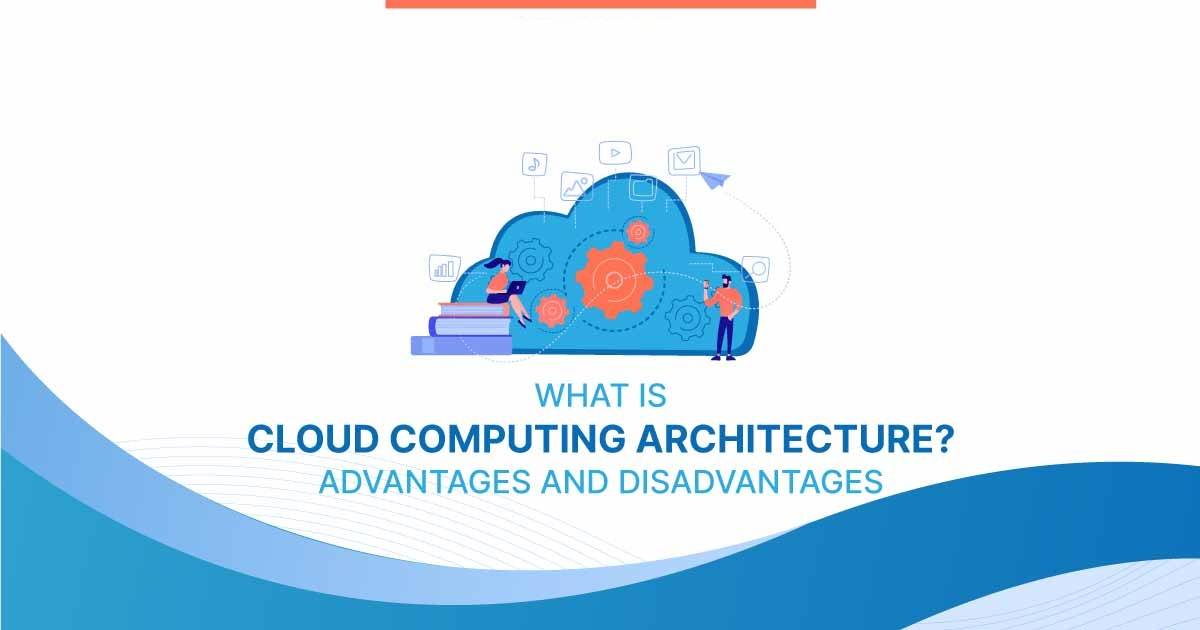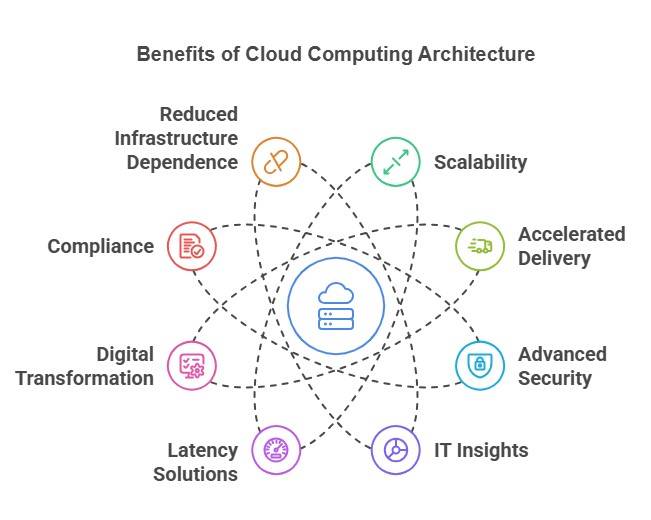What is Cloud Computing Architecture? Advantages and Disadvantages
Cloud computing is a virtual environment that delivers hosted services such as servers, databases, networking, analytics, and intelligence over the internet, ensuring innovation, flexibility, and cost-effectiveness. Cloud computing has transformed how people use to save documents and data previously.
- What is cloud computing architecture?
- Components of cloud computing architecture
- How does cloud computing architecture works?
- Why is it critical to carefully select cloud architecture?
- Why use cloud computing architecture?
- Advantages of cloud architecture
Interesed in making a career in cloud computing? If so, pursue online cloud computing courses and certifications from top vendors like - Coursera, OdinSchool, etc., or if you want to gain advanced knowledge, pursue an MCA in cloud computing. Plus, if you are short on funds or not sure whether the field is for you, start with free cloud computing courses and certifications online.
What is cloud computing architecture?
In layman’s terms, the architecture of cloud computing refers to how various technological components work together to create a cloud, in which resources are pooled and shared across a network using advanced technology, such as virtualization. Virtualization is the segmentation of one physical server into multiple logical servers. In a nutshell, “cloud computing architecture is a hybrid of (SEO) service-oriented and (EDA) event-driven architecture.”
Cloud Architect is the IT professional overseeing a company’s cloud computing architecture. As dated 10/04/2025, the salary for cloud architecture or Cloud Architect in India ranges from INR 7.5 Lakhs to 46.9 Lakhs, with an average annual salary of INR 27.0 Lakhs.
Cloud architecture consists of two major parts:
- Front End
- Back End
Here’s the cloud computing architecture diagram:
You can also explore: Introduction to cloud computing
What is the Front End of cloud architecture?
Everything with which the end user interacts is part of the front-end infrastructure. The user interface is the result of integrating various sub-components, such as browsers, tablets, mobile devices, etc. With the help of the front end, the end user can connect to the cloud computing infrastructure. In short, “the front end is the end that the client interacts with.”
What is the Back End of cloud architecture?
The back end is everything the user does not usually see and everything that processes the data. The service provider uses the back end to manage all the resources required to provide cloud computing services, such as data storage, security mechanisms, virtual machines, deploying models, servers, traffic control mechanisms, and so on. In short, “the back end is the end that service provider interacts with.”
Best-suited Cloud Computing courses for you
Learn Cloud Computing with these high-rated online courses
Components of cloud computing architecture
There are various components of cloud architecture. Some of those components are:
- Client infrastructure: The client infrastructure component is a frontend component that provides a graphical user interface (GUI) for users to interact with the cloud.
- Application: An application is any platform, such as an app or software, provided by a company through which clients can access the cloud.
- Service: A cloud service manages the type of service a client uses based on his needs. There are three types of services: SaaS (software as a service), PaaS (platform as a service), and IaaS (infrastructure as a service).
- Runtime cloud: The runtime cloud offers virtual machine implementation and runtime environment.
- Storage: The cloud computing storage component provides storage space in the cloud for managing and storing data. Cloud storage is of three types: public cloud, private cloud, and hybrid cloud.
- Infrastructure: The infrastructure component provides services on three levels: the host, the application, and the network. It includes the software and hardware components required to support the cloud computing model, such as storage network devices, servers, and other storage resources.
- Management: The management component is in charge of managing backend components such as storage services, applications, runtime cloud infrastructure, and security issues, as well as establishing coordination.
- Security: Security is the backend component of cloud computing that ensures data security in the cloud.
- Internet: The internet is the medium through which the frontend and backend components communicate and interact.
How does cloud computing architecture works?
The operation of cloud computing architecture depends on the type of cloud you use. As previously stated, there are various clouds, such as public, private, and hybrid, and no two clouds are the same. As a result, the working of cloud architecture depends on the type of cloud chosen. Let’s delve deeper into types of cloud architecture to understand their working better.
You can also explore: Evolution of cloud computing
- Public cloud architecture: A cloud services provider owns and operates computing resources, such as data storage, security mechanisms, virtual machines, etc, in a public cloud architecture. The internet is used to share and redistribute those resources among multiple tenants. The benefits of using the public cloud architecture include lower operating costs, easy scalability, and little to no maintenance.
- Private cloud architecture: A private cloud architecture is majorly owned and managed by a company. Private cloud architecture can consist of multiple server locations or leased space in geographically dispersed colocation facilities. Although private cloud solutions are typically more expensive than public cloud solutions, they are more customizable and can provide stringent data security and compliance options.
- Hybrid cloud architecture: A hybrid cloud environment combines the operational efficiencies of the public cloud with the data security capabilities of the private cloud. Hybrid cloud architecture help organizations consolidate IT resources while allowing them to migrate workloads between environments based on their IT and data security requirements by utilizing both public and private cloud architectures.
Why is it critical to carefully select cloud computing architecture?
When it comes to cloud solutions, cloud architecture is everything. In the physical world, for example, in a data center, everything runs on physical hardware (the servers can be virtual), but the network is never virtual; the connections between machines are always physical cables, making them easy to manage.
However, in the Cloud, which is a software-managed data center, not only are the VMs virtual but also the storage, network, and everything else. As a result, understanding the deployment requires the correct cloud computing architecture.
Why use cloud computing architecture?
There are various reasons for you, as well as organizations, to use cloud architecture. Some of those reasons are:
- Organizations can use hybrid cloud architecture to support real-time scalability for their applications.
- Organizations can use cloud architecture to accelerate the delivery of new apps, products, and services.
- Because the security is quite advanced, cloud architecture can help you save money and prevent data breaches.
- Cloud reference architecture can help organizations gain insight into IT spending patterns and cloud utilization.
- With the help of cloud architecture, you can solve latency issues and improves data processing requirements.
- Cloud-native architecture, such as Kubernetes, can be used to modernize applications and accelerate digital transformation.
- You or your organization can ensure compliance with the most recent regulations by utilizing cloud architecture.
- Organizations can use cloud architecture to reduce or eliminate their dependence on an on-premises server, storage, and networking infrastructure.
Advantages of cloud computing architecture
There are various advantages of cloud computing architecture, and some of those advantages are:
- Cloud architecture gives good user accessibility.
- Cloud architecture provides better disaster recovery.
- Cloud architecture makes overall cloud computing system simpler.
- There are fewer physical locations for hackers to target, reducing security risks.
- Services are automatically updated. Hence you don’t have to worry about updating it manually.
- Remote working is more efficient and flexible because of the mobility inherent in such systems, thus allowing teams to be more productive.
- Cloud architecture enables businesses to scale up and down their cloud resources quickly and includes a flexibility feature that provides a competitive advantage.
- This architecture eliminates latency issues, improves data processing requirements, lowers IT operating costs, and provides easy access to data and digital tools.
Conclusion
A cloud computing architecture is a set of components needed to provide a cloud computing service. Companies can work on lower budgets and eliminate on-premises infrastructure by using a suitable cloud based on their needs.
FAQs
What is cloud computing architecture?
The cloud computing architecture refers to how technology components collaborate to develop a cloud, wherein resources are grouped and distributed across a network using virtualization technology.
In how many sections the cloud computing architecture is split?
The cloud computing architecture is split into two sections: front end and back end.
Which two types of architecture are combined in cloud computing architecture?
Cloud computing architecture combines SOA (Service Oriented Architecture) and EDA (Event Driven Architecture).
What is a hypervisor in the context of cloud computing architecture?
A cloud hypervisor is a software that allows a cloud provider's physical compute and memory resources to be shared across multiple virtual machines in the context to cloud computing architecture (VMs).
What are the difficulties or disadvantages of cloud computing architecture?
Security and privacy, interoperability, portability, computing performance, and reliability and availability are the challenges in cloud computing architecture.
What are the most difficult challenges in cloud architecture?
The greatest challenge to cloud computing is the security and privacy of data.












